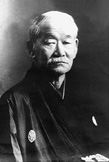|

JUDO HISTORY
Judo is a kind of self-defense, individual martial art; the main purpose is to throw, hold down, strangle or strike (strain the arm) the opponent within the boundaries of the rules. But what exactly does the word "judo" mean?
The word "ju" means "being natural, gentle and to behave reasonably". The word "do" ("way") has the meaning of a refined method, a spiritual way. Thus judo is not only "physical art", but it also lays significant stress on the mental education, the development of the moral culture of the human being. Without these abilities perfect technical preparedness wouldn't be possible in judo. In this martial art the rituals, selfdiscipline, concentration and fairplay are determinant. Real athletes with different ways of thinking battle each other on the tatami. Stamina and work bear success, strong physique and the ability to have your body under control. Educated experts can state that judo lacks any kind of misleading, false, mystical, untraceable and harmful ideology. Judo makes the athlete whole, prepared and complete.Judo has a long history of becoming a modern system of self-defending physical activity. The ancient Chinese predecessor of judo was called tai-jitsu. The techniques of tai-jitsu mostly include hits; somehow similar to the techniques used in modern-day karate. The dangerous and often harmful techniques were step-by-step replaced by the gentle, technically more developed but also more effective methods. The martial art jujitsu emerged, which still meant the "hard way" of practicing self-defense, that regularly lead to injuries during practice. In the late 19th century the basics of modern judo "Kodokan-judo" was created.
Kodokan-judo was founded by dr. Jigoro Kano, who was born in 1860 in Japan. During those times Japan was in the process of significant changes in society. Japan has always been an island - not just in a geographical way. When the feudal state administration was released, the people of Japan got fuddled by the never so big freedom and the invasion of Western civilization. With the ancient customs, also the traditional martial arts started to fall into oblivion. By that time Jigoro Kano was only 18, and extremely interested in martial arts, especially jujitsu. Therefore he went to the Institution of Martial Arts of that time to study the trickery of self-defense. He progressed well and quickly under the hands of his masters, so he was having only one aim before his eyes: to teach the physically and mentally broken Japanese people, who got unused to sports and all kinds of physical activities. He took the most useful elements from the self-defense martial art schools, and ignored everything that is useless or harmful to the human body. Jigoro Kano refined these techniques, made changes to them and brought them to perfection in a system of his own, creating his new school, called judo.
At the age of 22 in 1882 Jigoro Kano founded the Kodokan Institution, the "school to study the methods" he called. During that time judo became a sport able to be practiced by fair rules. Creating the new system of fallings the risk of injuries was reduced to the minimum.
During the 120 years since the foundation of Kodokan, judo has become more and more popular at a pace even Jigoro Kano hadn't expected. The number of registered athletes exceeded 5 million in Japan, and judo became compulsory in physical education. From martial art it became folk-educating physical activity, from that it became a real sport. Unfortunately Professor Kano, who practiced judo until the very end of his life,couldn't live to see this success. He died in 1938 at the age of 78.
At that time Judo was taught, spread popularized by high-qualified Japanese masters all around the world -the way Jigoro Kano himself imagined. After having lost World War II the policy of global opening was useful both for Japan and judo. Spreading judo in the world meant success in sports diplomacy for Japan. The always-curious United States and Europe were eager and hungry for the "Japanese mystery" and quickly accepted the Japanese ambassadors of judo, inviting teachers and trainers from the mother country of the sport.
More and more clubs opened. But soon it became clear that the mentality, philosophy, intellectuality, patience and faith in work of Asian people were not totally in line with the roots of European culture. But thanks for the persistence of the few obsessed people judo gained ground in the old continent. The dream came true;Jigoro Kano made a miracle with his Kodokan judo. The judo sport conquered the world. Under the past 120 years more than ten million people -equal the number of the population of Hungary, a member state of the European Federation- started practicing judo, and explored its wonderful world of fine movements and techniques and educational power.
Judo grew out to be more than just a temporary fashion, it became a real competition sport. During this process judo changed. Remember the fact, that Jigoro Kano created and refined the sport to be a self-defense-style physical activity. As a competition sport the aim of judo is to throw, hold down, strangle or strike (strain the arm or leg) the opponent within the boundaries of the rules to win. But judo is not just a single sport: it is also an important mean of education, as Jigoro Kano believed.
Judo is still ahead of a dynamic development, and can bring joy to the people who practice the sport at any level: both women and men, children and the old. Judo belongs to every-one.
"Use all of your spiritual powers so that you and others can live harmoniously"
Jigaro Kano
|